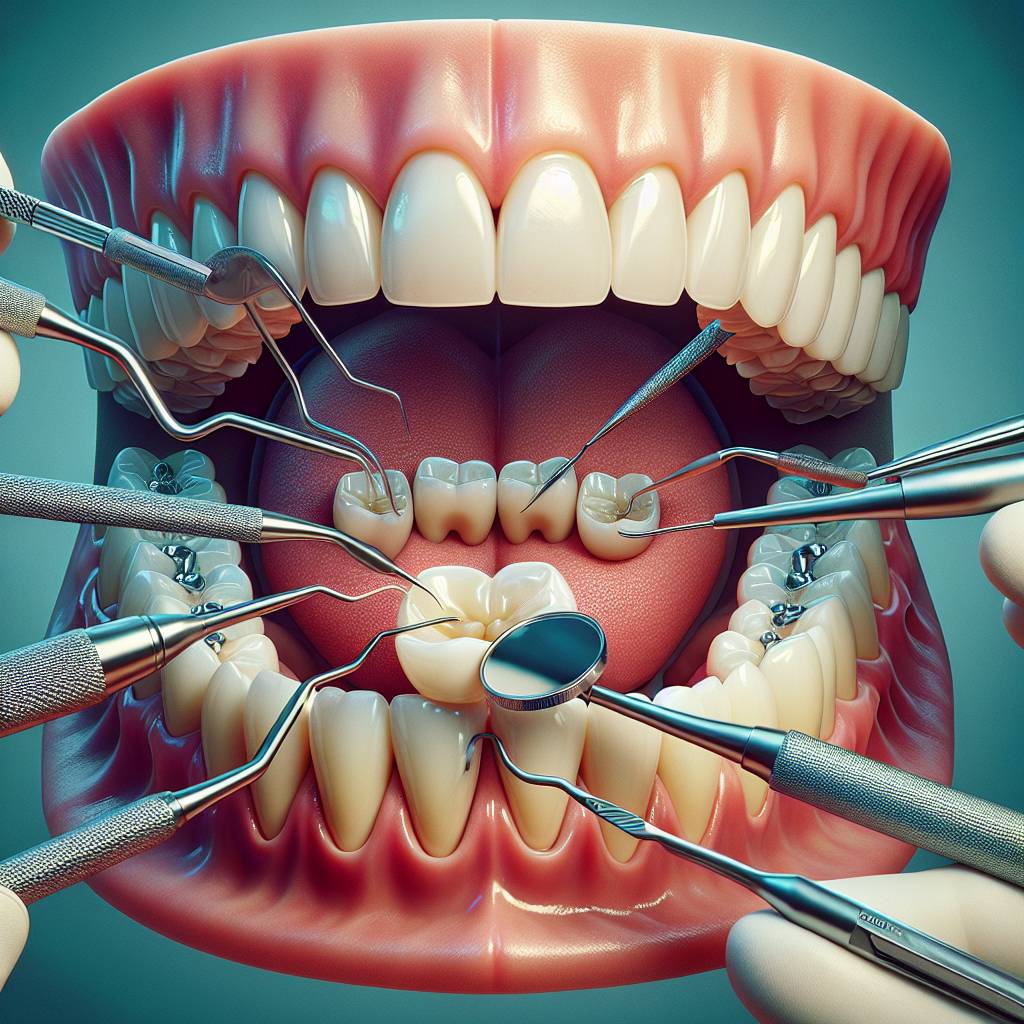Having gaps between teeth can be an aesthetic concern for many people. Fortunately, there are a number of different options available to fill these gaps and restore the uniformity of your smile. From braces and dental veneers to bonding and crowns, there is a procedure that can help you achieve the look you desire. In this article, we will discuss how fill gaps between teeth and the various treatments available to help you close the gaps in your teeth.The options for filling gaps between teeth depend on the size and location of the gap, as well as the patient’s individual needs. Generally, there are three common ways to fill gaps between teeth: orthodontic treatment, bonding and veneers. Orthodontic treatment includes braces or clear aligners to move the teeth into a better position over time. Bonding is a procedure in which a tooth-colored material is used to close gaps or cover discolored or chipped teeth. Veneers are thin shells of porcelain that are bonded to the front surface of the teeth to help fill gaps and improve appearance.
Closing Gaps Between Teeth
Closing the gaps between your teeth can have a number of benefits. Not only can it improve your overall smile aesthetically, but it can also increase your oral health and well-being. From addressing issues with tooth decay to improving the function of your bite, closing gaps between teeth can have a positive impact on your overall oral health.
Aesthetic Benefits
One of the most apparent benefits of closing gaps between teeth is the aesthetic appeal that it brings to your smile. Having gaps between your teeth can make you feel self-conscious about smiling or speaking in public. By having them closed, you can feel more confident in how you look when you smile and be proud to show off your smile.
Prevents Tooth Decay
Gaps between teeth can leave some areas of enamel more exposed than others, making them more susceptible to bacteria and plaque buildup. Closing these gaps will help protect these areas from decay and other oral health issues such as gum disease. This will help keep your teeth strong and healthy for years to come.
Improves Bite Functionality
Gaps between teeth can also make it difficult for you to properly bite down on food or chew properly. By closing these spaces, you will be able to bite down without any discomfort or difficulty, allowing you to enjoy eating without any pain or discomfort.
Overall, closing gaps between teeth has many benefits that go beyond just improving the aesthetic appeal of your smile. Whether it’s preventing tooth decay or improving the function of your bite, closing gaps between teeth is an effective way to improve both the look and feel of your mouth!
How Can a Dentist Help Fill Gaps Between Teeth?
Having gaps between your teeth can be embarrassing, and can also lead to dental issues such as gum disease and tooth decay. Fortunately, there are several treatments available to fill in those gaps. A dentist can help you decide which option is best for your particular situation.
One of the most common treatments for filling gaps between teeth is dental bonding. This involves applying a composite resin material to the surface of the tooth, which is then shaped and hardened with a special light. The result is a seamless, natural-looking smile. Bonding can last up to 10 years with proper care and regular dental visits.
Another option is porcelain veneers. Veneers are thin shells that are custom-made to fit over the front surface of your teeth. They can be used to hide any imperfections or discolorations on your teeth, as well as closing gaps between them. Veneers are incredibly strong and durable, and with proper care can last up to 15 years or longer.
If you have larger gaps between your teeth, then orthodontic treatment may be the best option for you. Orthodontics involves wearing braces or other devices to gradually move your teeth into the desired position over several months or even years. This will help close any large gaps while also improving the overall appearance of your smile.
Finally, there are dental implants which can be used to fill in gaps between teeth. Dental implants involve surgically placing metal posts into the jawbone which act as artificial roots for replacement teeth that look and function just like natural ones. Dental implants are an excellent solution for missing or broken teeth, as well as closing gaps between them.
No matter what type of gap filling treatment you choose, it’s important to see a qualified dentist who will be able to assess your individual situation and recommend the best course of action for you. With proper care and regular checkups, you’ll be able to enjoy a beautiful smile that lasts for years to come!
Bonding
Bonding is a dental procedure used to fill gaps between teeth. It involves the application of composite resin material on the tooth surface that is then shaped and hardened using a specific dental light. Bonding helps to improve the overall appearance of the smile and can be done in one visit. The results of bonding are not permanent, and may need to be touched up or replaced over time.
Veneers
Veneers are another option for closing gaps between teeth. Veneers are thin shells made of porcelain or composite resin that are bonded to the front surface of the teeth. Veneers can be used to correct alignment issues, close gaps, and whiten discolored teeth. This procedure is more expensive than bonding but has a longer-lasting result.
Crowns
Crowns are an option for closing gaps between teeth when other treatments do not work. A crown is an artificial cap that fits over a damaged or misshapen tooth, restoring its shape and function while also filling in gaps between teeth. Crowns can be made from metal, porcelain, or resin materials depending on the patient’s needs and preferences.
Implants
Dental implants are another option for filling gaps between teeth. Dental implants involve surgically placing a titanium post in the jawbone below the missing tooth and attaching it to an artificial tooth or bridge above it. Dental implants look and feel like natural teeth and provide a more secure fit than traditional bridges or dentures. They also help preserve bone structure in the jawbone.
Orthodontic Treatment
Orthodontic treatment is another option for closing gaps between teeth. Orthodontic treatment involves using braces or other appliances to realign crooked teeth into their proper position while also helping to close any existing gaps. This treatment can take several months to complete but will result in improved oral health as well as a better-looking smile.
Different Materials Used to Fill Gaps Between Teeth
Gaps between teeth, also known as diastemas, can be caused by numerous factors, such as genetics, tooth loss, or poor dental hygiene. To close the gap and restore functionality and aesthetics of the smile, dentists may recommend a variety of materials to fill in the space. Common materials used for closing gaps between teeth include composite resin, porcelain veneers, crowns or bridges.
Composite resin is a putty-like material made of acrylic resin and other fine particles that can be quickly applied to fill in gaps between teeth. Resin is durable and designed to look natural when it hardens. It is also relatively affordable and easy to apply in a single visit. Porcelain veneers are custom-made shells that fit over the front surface of a tooth. They are made from thin layers of porcelain that blend with surrounding teeth for an even appearance. Veneers are stain-resistant and have a long lifespan when properly cared for.
Crowns are another popular option for filling gaps between teeth. Crowns are hollow caps made from metal or porcelain that fit snugly over an existing tooth or implant post to cover any damage or gaps near the gum line. Crowns can be used to protect weak teeth from further damage while filling in gaps near the gum line. For larger spaces between teeth, bridges may be recommended by a dentist. Bridges consist of one or more artificial teeth held together by metal bands anchored on each side by existing teeth or implants posts for support.
No matter what material is used to fill gaps between teeth, it is important to have regular checkups with a dentist in order to maintain good oral health and keep any issues from developing or worsening over time.

Filling Gaps Between Teeth
The process of filling gaps between teeth, known as dental bridgework, is an important part of maintaining good oral health. Bridgework can help to improve the appearance of your smile, as well as restore lost function to your teeth. In order to get the best possible results with bridgework, it is important to understand the different types of treatments available and what each one entails.
The first step in the process of filling gaps between teeth is to determine what type of bridgework will be most appropriate for your particular situation. Depending on the size and shape of the gap, different types of bridges may be recommended. If the gap is small, a removable partial denture may be used. However, if the gap is larger, a fixed bridge or implant-supported bridge may be necessary.
Once a treatment plan has been determined, it is time for the dentist to begin preparing the teeth that will be used for bridgework. This typically involves removing any existing decay and shaping the surrounding teeth in order to make room for the bridge. The dentist will also take impressions of your teeth so that a custom bridge can be created that fits perfectly into your mouth.
After preparing your teeth for bridgework, it is time for the actual placement of the bridge. This may involve attaching a metal framework directly onto your existing teeth or placing implants into your jawbone in order to support a fixed bridge. Depending on which type of bridgework you are having placed, this step may involve multiple appointments over several weeks or even months in order to ensure proper healing and integration with your existing teeth structure.
The last step in this process is having any necessary adjustments made to your new bridge so that it fits properly and functions as it should. Your dentist may also provide you with instructions on how to care for your new bridgework so that it lasts as long as possible and remains in optimal condition. With proper care and maintenance, you can expect your new bridges to last anywhere from 10-15 years before needing replacement or repair work done on them.
How Long Does It Take to Fill Gaps Between Teeth?
Filling gaps between teeth, or diastema closure, is a common dental procedure. The amount of time it takes to complete the treatment depends on the type of procedure chosen and the complexity of the case. Generally, diastema closure can take anywhere from a single appointment to multiple appointments over several visits.
For simple cases, the diastema closure may only take one appointment. During this visit, your dentist will make sure your teeth are healthy and properly aligned before proceeding with treatment. Then they may use composite resin to fill in the gap between your teeth or place an orthodontic appliance such as braces or Invisalign to shift your teeth into place.
In more complex cases, more time may be needed for treatment. If orthodontic appliances are being used, you may need to schedule multiple visits for adjustments and monitoring of your progress. Depending on the severity of the gap between your teeth and how much shifting is needed, treatment can take anywhere from a few weeks to several months.
Your dentist will be able to give you a better estimate of how long it will take to fill gaps between your teeth based on their evaluation of your particular case. They can also provide more information about all available treatments so that you can make an informed decision about which option is best for you.
Costs Associated With Filling Gaps Between Teeth
The cost of filling gaps between teeth can vary depending on the type of treatment you choose and the severity of your case. Generally, treatments for closing gaps between teeth may include braces, bonding, veneers, and dental implants. Each of these treatments has its own associated costs.
Braces are a common way to close gaps between teeth and typically involve wearing brackets and wires that gradually move your teeth into the desired position. Depending on the severity of your case, braces can cost anywhere from $3,000 to $7,000.
Bonding is a cheaper option than braces and involves applying a composite material directly to your teeth to fill in the gaps. It is a relatively simple procedure that usually only takes one visit to the dentist and generally costs around $500-$1,000 per tooth.
Veneers are thin pieces of porcelain that cover the front surface of your teeth in order to close gaps or correct misalignments. Veneers are more expensive than braces or bonding but can provide a more natural-looking result with less maintenance. The cost for veneers typically ranges from $900-$2,500 per tooth.
Dental implants are an option if you have missing or severely broken down teeth due to decay or trauma. Implants require surgery and involve placing metal posts into your jawbone that act as an anchor for prosthetic replacement teeth. Dental implants cost much more than other treatments and usually range from $1,000-$3,000 per tooth depending on the complexity of the case.
Overall, the cost of filling gaps between teeth can vary significantly depending on which treatment option you choose and how severe your case is. It’s important to consult with your dentist so that they can help you determine which treatment is best for you based on your budget as well as any potential risks associated with each option.

Conclusion
Fill gaps between teeth is a common issue and can be treated effectively with the right treatment. There are various options available for closing these gaps, such as braces, dental veneers, crowns, and fillings. The best option for you will depend on the size of the gap and your budget. Before beginning any treatment plan, make sure to discuss your options with your dentist to ensure that you are receiving the most appropriate treatment for your needs. With the right care and maintenance, it is possible to fill gaps between teeth and restore your smile.
No matter what type of treatment you choose, be sure to follow your dentist’s instructions for proper care and maintenance of your smile. Regular brushing and flossing should be part of your daily routine to maintain good oral hygiene. If you experience any discomfort or pain after a procedure, contact your dentist immediately to discuss possible solutions. With the proper care and attention, it is possible to fill gaps between teeth effectively and achieve a beautiful smile once again!

